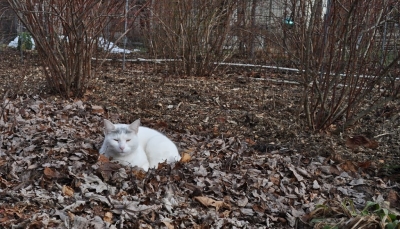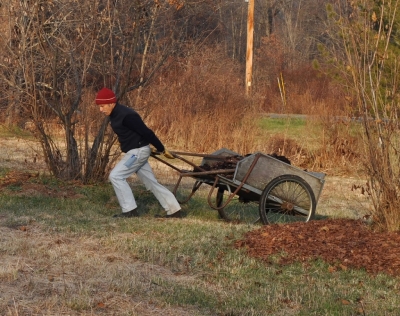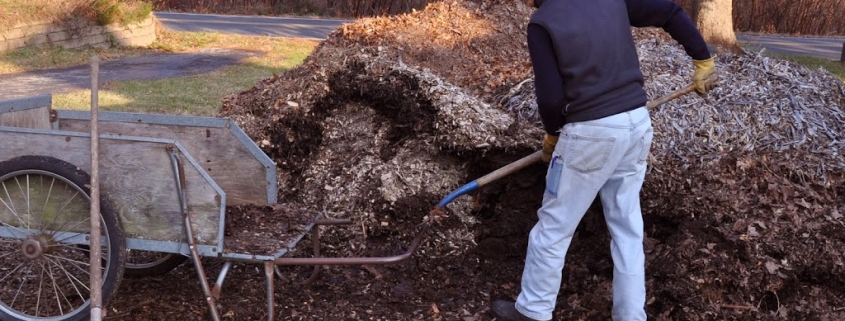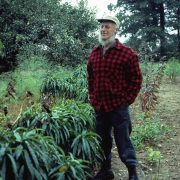I’m getting a lot of mulchercise here at the farmden these days. It’s good for me and good for the ground and, in turn, my plants.
Four piles of materials await me: a pile each of new and old wood chips, and a pile each of new and old leaves. The new pile of leaves is going to sit out this year’s mulchercise sessions. After a winter of settling and some decomposition, that pile will be just right for being planted with squash and melon plants. The lanky vines can run wild over the pile through summer and then, next year at this time, I’ll spread the much-reduced pile.
Last year’s leaf pile, from which I harvested this year’s squashes and melons, is part of my present mulchercise. The now dark brown material is getting hauled over to and spread beneath currant bushes, over the asparagus and flower beds, and on ground that will be home, next spring, to a new bed of Fallgold raspberries.
On to the wood chips . . . the old pile? That’ll go beneath various trees.
It’s amazing how simply spreading organic materials on top of the ground can bring so many benefits. Physically, that fluffy layer cushions the impact of raindrops so that moisture can percolate slowly into the
 |
| Me on the “abs & bicep” machine |
ground rather than pound the surface, sealing it, and running off to make gullies. Mulch also insulates the ground, modulating swings in temperature to keep roots and other soil denizens happier. Next summer, the mulch will slow evaporation of water from the soil.
Biologically, mulch is food fungi, bacteria, and other soil organisms, the lion’s share of which are beneficial. As the leaves and wood chips go through cycles of being digested and excreted, what’s eventually left is humus, a witch’s brew of beneficial, organic compounds, which, in turn, is tied to nutritional benefits to plants. During decomposition, nutrients gathered up into leaves and wood are released into the soil, for plant use. Organic acids released during decomposition further nourish plants by dissolving additional nutrients from the rock matrix in which the soil was formed. And finally, organic chelates in humus grab onto some nutrients to render them more readily accessible to roots.
——————————————–
I didn’t forget to mention my new wood chip pile; that mulch is getting carted over to blueberry heaven, heaven for the blueberries, that is. (Also for me, during summer’s harvest.)
Each autumn, right after blueberry’s leaves drop, I spread 10 to 20 pounds of soybean meal over the thousand square feet of planted area, then top it with a fresh layer of wood chips (this year) or leaves or
 |
| George is company, but not much help |
wood shavings. Some years I also spread sulfur pellets over the ground to maintain the soil acidity that blueberry plants require. Not that often, though, because another benefit of an organic mulch is that it buffers changes in soil acidity, offering plenty of wiggle room in what range keeps the plants happy. The mulch also buries any berries infected with “mummy berry” disease, a problem I never have because the mulch layer prevents any spores that might be present from wafting upward to re-infect berries next year.
Blueberry bushes have shallow root systems, most roots descending less than a foot deep, with no root hairs. Thirty years with 2 to 3 inches of organic mulch laid atop the ground has created a soft, moist, heavenly environment for blueberry roots.
———————————————-
I can just picture some readers “raising their hands” to point out that adding fresh, low nitrogen, organic materials to the soil results in nitrogen starvation of the plants. This science-y, oft repeated (and printed) myth needs debunking.
Soil bacteria and fungi need to eat both nitrogen and carbon. Wood chips and leaves are high in carbon
 |
| Me on the “quads and aerobic machine” |
but low in nitrogen, so these microorganisms grab at any other nitrogen in the ground to eat along with their fresh chips or leaves. Bacteria and fungi are better at garnering soil nitrogen than are plants, so plants are starved for nitrogen. Only temporarily, though, until some of the digested carbon is given off as carbon dioxide and what’s left are the higher nitrogen dead remains and excreta of bacteria and fungi.
When fresh chips or leaves are used as mulch, decomposition proceeds very slowly at the interface of soil and mulch. So slowly that nitrogen is re-released into the ground at about the rate it’s being tied up. Digging chips or leaves into the soil will definitely cause a temporary tie-up of nitrogen; mulching with these materials will not.
———————————————-
So here at the Springtown Farmden Health Spa, I am mulchercising away. I start at the “abs and bicep machine,” rolling what looks like a garden cart
 |
| Me on the “rotary torso machine” |
over to the mulch pile and then using what looks like a pitchfork to load leaves or chips onto the cart. Then it’s on to the “quads and aerobic machine,” whence I pull what looks like a cart full of leaves or chips over to some plants in need of mulch. Next, it’s the “rotary torso machine,” which looks like I’m scooping leaves or chips from the cart, twisting around, and then dumping it beneath a plant. Finally, back to the “abs and bicep machine,” for another rep. I should be able to get a dozen or so reps in before the mulch freezes solid for the winter.











Loved reading this… Informative and funny! I do a thing in the garden I call garden yoga. My garden is so small when everything is at full size there is no place to walk so I have to stoop and stretch really far to pick,weed or do anything. I was grumbling about this until I realized it was probably really good for me.
I often do a similar yoga, trying to get in among my plants without stepping in the wrong place.
Love it! When I think of all of the wasted physical energy released in a suffocating clausterphobic gym that delivers no end product from that strained labor I consider it such a missed opportunity. Why not instead utilize the release of that physical energy toward something productive, manufactured in the quiet peaceful outdoors with the sun and air gently beating down on your shoulders. That’s the way I look at it anyway — no gym memberships for me.
It seems that successful gardening can be condensed down into simply collecting and spreading plentiful organic matter. My only problem is collecting enough of it. That’s my challenge anway. It seems you have developed the long term relationships and connections that keep a copious supply delivered to your property.
You got it right! As for finding sources of organic matter, keep your eyes and ears open. Over the decades, I’ve collected such material as might way right-of-way mowings, wood chips, neighbors lawn clippings (be careful, some people use herbicides), and have had a truckload of lake weeds (harvested by my municipality) dumped here.
Thank you for explaining the mulch nitrogen/carbon release process. Very interesting.
Great post!! Where do you get your soybean meal- and is it an organic source? I would love to get some more free mulch, but have scored only 1 truckload so far! Hopefully they will come back and I can get some more! It is definitely quicker than picking up loads in my hatchback! Also I got your weedless gardening book as a gift for my dad, I am excited to give it to him! Maybe we will try your method this spring!
Do try my WEEDLESS GARDENING method; it really does work.
I get soybean meal from a feed store (Agway, around here). I imagine it’s GMO so it’s not organic. Organic is hard to get and much more expensive. These days, I use very little soy. Most of my plants nutrition comes from decomposing organic materials, which is even better than soybean meal whether or not the meal is organic.
Great post!! Where do you get your soybean meal- and is it an organic source? I would love to get some more free mulch, but have scored only 1 truckload so far! Hopefully they will come back and I can get some more! It is definitely quicker than picking up loads in my hatchback! Also I got your weedless gardening book as a gift for my dad, I am excited to give it to him! Maybe we will try your method this spring!
How do you keep the large pile of leaves that you collect in place? I feel like if I tried that it would be scattered to the wind in short order. I could see throwing a tarp over it all somehow, but figure that might then suppress the desired composting process.
I don’t know why they stay in place but they do, especially after a little rain. I wouldn’t cover the pile with a tarp because I want the pile to get wet and start decomposition whenever the weather is warm enough.
Wow, you have some great posts on here about gardening. Thank you for sharing your expertise with someone like me, who doesn’t have a green thumb whatsoever!
http://evergreenos.com/installation.htm
Thank YOU!
What if I get a load of mulch with gray mold? I just finished mulchercising a huge pile into a new bed that will get bare root fruit trees this spring. As I was shoveling, a gray “smoke” would rise out of it and I could see clumps of gray mold on the wood. I’ve heard white stuff is good but what about the gray? Did I just do more damage than good?
Not to worry. That mold is attacking dead wood so is probably a saprophyte.
Lee, I agree that high carbon mulch like wood chips and even sawdust are not a problem for soil nitrogen if it is laid as a mulch on top of the soil, rather than tilled in. Leaves, however, have a lot of nitrogen. I know that because they grow worms and melons well. It takes nitrogen to grow leaves, and that nitrogen is still there when they fall off the tree. Carbohydrates like cellulose add energy to the nitrogen in the leaves, making a well-balanced soil food.
A real problem mulch is finely ground bark. Trees put preservatives into their bark to prevent rot, disease, and pests. When the bark is ground and spread as a mulch, the preservatives leach out of the broken cells, and kill all the bacteria, fungi, insects, and worms. The soil dies, and then becomes compacted because there are no worms and other soil dwellers to lighten it with their tunneling.
I came to your site from an article debunking the “rumors” about high-carbon mulches. But I cannot find it on your site.
The debunking article — one of them, at least — is at . As far as leaves vs. wood chips of sawdust, yes, leaves do have a much lower C/N than sawdust or wood chips (25 to 50 for leaves vs 500 for sawdust) but the leaves are still higher than the ratio in stabilized organic matter, which is about 10/1. Probably no problem if the soil is reasonably fertile or if they’re mixed into the soil sometime before planting. To say that bark “kills all the bacteria, fungi, insects, and worms” is a bit strong. If that were the case, our forest soils would be dead. These critters do eventually break down bark; they just wait their turn for food they can use.
I loved this post.I read your blog and you are all ways comming out with some grate stuff…i shared this on my facebook and my followers loved it keep up the good work 🙂
Freedom APK
Thank you for explaining the mulch nitrogen/carbon release process. Very interesting. 😀 (y)
Best Cat Breeds